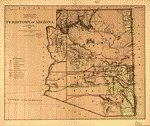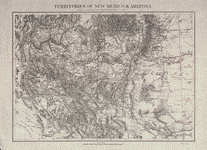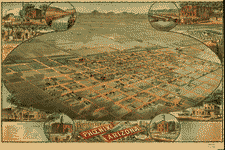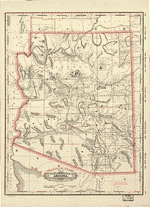Arizona: Historical Maps
R. P. Kelley’s Map of the Territory of Arizona, 1860, shows the territory of Arizona when it ran east to west and included what became the southern portion of Arizona and southwest portion of New Mexico. The map details Castle Dome, Ewell, and Mesilla counties, Tucson, and Fort Yuma, California.
The legend at the top right of the map explains the markings for:
Overland mail routes
Mail stations
Mines
Forts
Roads
Towns
County towns
Territory and county lines
This 1867 map of the territories of Arizona and New Mexico, with portions of northern Mexico, shows how the terrain and location of water shaped transportation routes hundreds of years before these routes were adapted for 19th century travel.
Communities in northern Arizona include Hardyville, Mohave City, Wickenburg, and Prescott, the first capital of the territory. Tucson and numerous smaller communities are noted in southern Arizona and northern Mexico.
This indexed map of Arizona, dated 1876, presents a wealth of information about the growing transportation infrastructure.
Phoenix is noted along with Hayden’s Ferry and Dragoon Spring.
At this time, we do not have access to the index.
This Department of the Interior General Land Office map of 1876 presents information about land use:
Subdivided townships
County seats
Cities and towns
Boundaries of land districts
Limits of railroad land grants
Military reservations
County boundaries
Indian tribal lands
This 1879 map, from the U. S. Army Office of the Chief of Engineers, 1860, documents the challenges of building railroads and roads through the Southwest. Mountain and passes are shown in great detail.
This two-state map, 1883, describes the fifty-mile limit along the Atlantic & Pacific (A&P) Railroad right of way. The sections (one square mile or 640 acres) were granted to the A&P railroad by the federal government in a checkered pattern. The railroad could sell the land, providing funds for construction.
Such land grants greatly influenced the development of Arizona.
This 1885 lithograph, a bird’s eye view of Phoenix, includes the courthouse, hotel, billiard hall, church buildings, a school, bank, and other civic buildings. Irrigation infrastructure includes:
Dutch Ditch
Maricopa Canal
Grand Canal
Arizona Canal
The map contains a description of Phoenix, including a statement that the population was about 3,500.
This 1887 map of railroads and county lines is similar to but less detailed than the 1879 map by the U.S. Army Office of the Chief of Engineers.
At this time, we do not have access to the index.
The 1887 map of the Arizona territory, from the United States General Land Office, includes high-lighting of land reserved for military and Indian tribes and forty- and fifty-mile limits of railroad land grants.
Request Membership Information
The content contained herein does not necessarily represent the position of NSDAR. Hyperlinks to other sites are not the responsibility of the NSDAR, the state organization or individual DAR chapters.
Unless otherwise noted, images are courtesy of Arizona State Society, DAR, Daughters.









